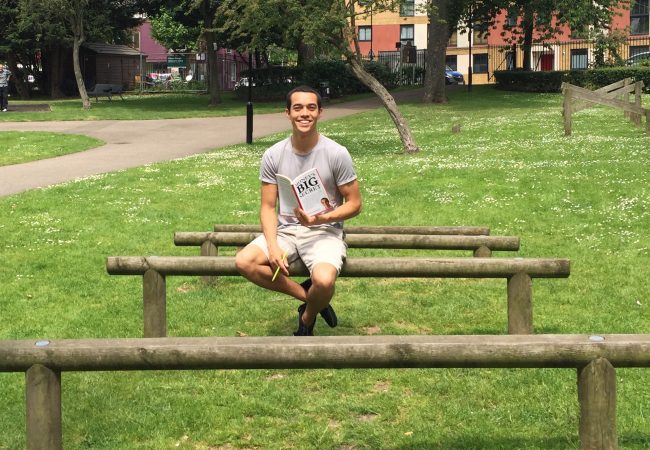You can live for free, be anywhere, do anything. Deepak…
Harris Tweed: Wear The Greatest Fabric of All
Our world is increasingly one devoid of reality and humanity.
Patrick Grant, Director of Savile Row besoke tailoring firm Norton & Sons, explains how current lifestyles are now completely separated from the makers of the products used, food eaten, clothes worn.
It’s a problem echoed by creative designers with marketplaces such as Videohive and iStock reducing their work’s value, and also stated by old fashion designers talking of the new.
Lara Platman, photographer and writer, sought to change this a little when in 2010 she spent almost a year with the farmers, mill workers and weavers of the Hebrides islands off the Western coast of Scotland, where the world famous Harris Tweed is made, and creating a printed ethnography of the land in Harris Tweed, From Land to Street.
“Harris Tweed is the world’s most iconic cloth. It is perhaps Britain’s greatest brand. It has incredible meaning to millions of people around the world. Its orb symbol is instantly recognisable. It is owned by no one, and marshalled by just a few.” – says Patrick Grant in the books’ forward.
Harris Tweed, From Land to Street opens with landscapes of Harris and Lewis, the island of the Hebrides. The book was published to celebrate 100 years since the Harris Tweed Orb stamp was registered and to inspire people to visit the beautiful islands.



“Harris Tweed is the only fabric that has its own legislation; in fact it is one of the only items in the British manufacturing industry to do so. ‘Harris Tweed means a tweed has been hand-woven by the islanders at their homes in the Outer Hebrides, finished in the Outer Hebrides, and made from pure virgin wool dyed and spun in the Outer Hebrides’. This definition became statuary when the Harris Tweed Act was passed in 1993. Only tweed made this way can be given the Harris Tweed trademark ‘Orb’ stamp, which the Harris Tweed Authority gives to every piece of cloth.”
“As our lives are played out over the ether – by electronic mail and instant message, in online shops – we are becoming detaching from what is real and substantial and true. In reaction to this steady advance in the world of the unreal we are slowly beginning to rediscover a love for the products and the ways that root us in a world of sub stand and reality and enduring value. We want to feel connected; and the further we push into the digital world the more we feel the need to tie ourselves to the traditional, the artisanal, the handcrafted.” – Patrick Grant

Since 2005, the Harris Tweed industry on the islands has been growing again slowly. In the 1970s and early 80s there were six main mills employing up to 900 weavers, but now there are several hundred.
The wool used for Harris Tweed used to come from the blackface sheep of the Hebrides, but now it is imported also from Scottish cross-breeds and Chebiot sheep.
“Different breeds give various thicknesses and qualities of fleece. Sheep living high up in exposed environments, such as the high moorlands in the Outer Hebrides, provide a stronger, bulkier and coarser fleece.”

“Bill Walton is one of the best-known faces in the British wool industry, having worked in the business for the past forty years.”
Lara Platman captures the process of Harris Tweed production, from shearing, washing, packing, dying, mixing, and carding, which then gets sent to the weavers in the form of beams and bobbins with instructions and colour ways from the mills’ designers.


“With each delivery of beams and bobbins from the mill, the weaver may have to set up the loom differently depending on the pattern… Following a recipe card supplied by the mill, the weaver punches holes in a plastic pattern roll. When placed in the loom, this releases each respective yarn at the right moment to produce the weft or weave.”
Some very experienced weavers do not use recipe cards and count up to twenty colours in their head at once. As Bruce Lee said,
All fixed set patterns are incapable of adaptability or pliability. The truth is outside of all fixed patterns
Community individuals are profiled, stories, past careers, and weaving set-ups. The colour of the tweeds often reflect the stunning landscape of Harris and Lewis islands.


“The Amhuinnshuidhe estate is a reminder that Harris Tweed owes its success as an industry to Catherine Herbert, Countess of Dunmore. Her husband, Alexander, the 6th Early of Dunmore, inherited the Isle of Harris from George Murray, the 5th Earl of Dunmore, who had bought it for £60,000 from the bankrupt Alexander Norman Macleod in 1834.
“In 1846 the countess had lengths of Harris Tweed made into jackets for the staff on her estate. Realising that the tweed made ideal clothing for country pursuits – waterproof, hardwearing and smart – she introduced it to her high-society friends, and it soon became fashionable for hunting and sporting attire.”
The quality of the tweed is marshalled by the Harris Tweed Authority, within which it is a full time job to go round the mills, and another full time job to steam the orb stamp onto each cloth.
“The Harris Tweed Authority sends a man round to the mills daily to check the job sheets, the cloth and the work of weavers who have made it. The authority keeps ‘passport’ information on each meterage of material woven. It knows who has woven it, the pattern and the date; it also knows which mill has commissioned the material or if it was from an independent weaver. It has records that date back well over a hundred years.”
A beautiful book, Harris Tweed From Land to Street is now available in paperback from Frances Lincoln publishes, is well worth a read for all interested in fashion, or re-discovering the craftsmanship of a technique hundreds of years old.
- Savile Row: The Master Tailors of British Bespoke
- Icons of Mens Style
- The Perfect Gentleman: The Pursuit of Timeless Elegance and Style in London
- The London Cut: Savile Row Bespoke Tailoring




Tom, I wish I had Tweed! This post is awesome! I enjoyed the photos and everything else. I’m wondering if anyone else makes tweed? Thanks for posting this great article!
hey Tom, i learned a lot from this post! these photos are beautiful; hopefully they have this book at my library. cheers!
Amazing photos. I have been wearing tweed for decades but never knew its background. Do you know any tweed designers?
Many Thanks
Richard.
Hi Tom,
I love your article about tweed. It’s a fabric with amazing properties perfect for country pursuits. The book is very intriguing, and photos are simply amazing. Does Harris Tweed have any one that tweets about it a lot? I will definetley recommend this article to some friends – thanks!
Hi Tom,
Kudos for a great article, the present generation needs to be reminded of the great British tradition of tweed. Harris Tweed is an icon of British fabric industry. The best quality of tweed coming from sheep reared in high altitudes of the Island of Hebridges in Scotland having much stronger, bulkier and coarser fleece. Now I wish to own a jacket in Harris Tweed.
Hi Tom, thank you for this very comprehensive post on Harris Tweed. I came across your blog post while doing research for a college assignment and your references and sources are a great help. You have managed to condense the history of Harris Tweed and made it an interesting read. I love the photos and book references you include in your post. The effect modern living has on the industry is also a very valid and interesting discussion topic. I find it fascinating that we are slowly seeing a return to more traditional values and customs. May i ask, what prompted you to feature this great and very specific article? I will most definitely research the book by Lara Platman.
I love tweed. There really is nothing like it. Thanks for the in depth post.
This is awesome, wish they made this kinda book for all suit things
Hello Tom! This an eyeopening article about tweed. I am from the United States and did not realize the history of tweed or the Harris Tweed brand. I do love the fabric and now have a greater appreciation for it as a result of reading your article. Do you know of any other manufacturers of tweed products? If so could you let us know?
Thank you for the great article!